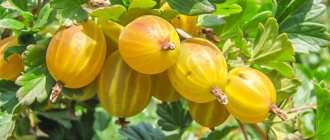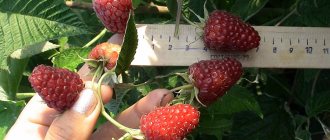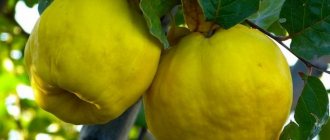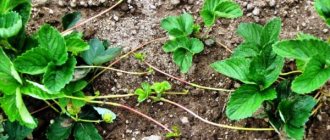Preparing gooseberries correctly for the dormant period in the fall means laying the foundations for a rich harvest for the next season. A shrub that has spent a lot of effort on bearing fruits needs the care of a gardener. Proper care of gooseberries in the fall will help curb the threat of infections. The berry crop will accumulate enough nutrients for proper formation and successful wintering.
Treatment of the root zone
From spring to autumn, the gardener monitors the cleanliness of the tree trunk circle of berry bushes: removes weeds, loosens, mulches. After all, hygiene in the cultivation of fruit crops is a third of success. But, despite this, after harvesting the gooseberry bushes in the fall, there is no end to the work:
- The first step is to rake out fallen berries and leaves. If traditionally prickly varieties grow, then, protecting your hands with thick gloves and armed with a convenient tool, including tweezers, they restore order between the gooseberry stems, without leaving any plant residues before winter.
- If there are diseased, mummified fruits left on the branches, they must be removed. Not a single berry should remain on the gooseberry before winter. This will deprive fungal spores or pest larvae of comfortable wintering conditions.
- Weeds that have managed to appear are pulled out. The upcoming feeding will provide them with a rich nutritional base: the weeds will grow, taking away nutrition from the gooseberries.
- When the trunk circle and the space between the stems are completely cleared, the soil is carefully loosened. The closer to the center of the circle, the shallower the depth: there the soil was not so trampled down while the harvest was in progress. Towards the outer circle of the crown projection - deeper: during the removal of fruits around the bush, the earth was compacted with feet, so air access to the roots is limited.
- Outside the crown projection, where there are no more gooseberry roots, the ground is dug up. Depending on the distance between the bushes and the spread of the roots of neighboring plantings, digging from half to full bayonet depth.
- The tree trunk circle is sprinkled with a continuous layer of wood ash. The double effect of this measure is additional feeding of gooseberries and a blow to pests and their larvae.
- The last stage is mulching the tree trunk circle. A thick, at least 10 cm, layer of mulch will protect the roots from freezing and create more comfortable conditions in winter.
If you use compost and humus, then two problems are solved at once - insulation + fertilizing. Important! You can cover the ground with peat, rotted sawdust, and straw. But the last two options often harbor mice. Small rodents love to eat gooseberry trunks in winter. For protection, rubber hoses, car tires or tube cuttings are laid out around the stems.
Preparation stages
First of all, you should spray the bush with 1% Bordeaux mixture or any other fungicide. This is done only after harvesting, but not before. This way you can protect your gooseberries from anthracnose, powdery mildew, spider mites and other diseases and pests.
Removing plant debris from under bushes also seems to be a necessary measure. It is carried out in two steps. The first is carried out after fruiting, the second - after all the leaves have fallen from the bush. It is better to burn everything collected or, as a last resort, take it outside the site as far as possible. Taking it to a compost heap and using plant debris as mulch will not do any good. With the onset of spring, diseases and pests will spread throughout the entire area at the speed of the wind.
Once the garbage has been removed, you can immediately dig up the ground under the bushes - 10 cm in the area of the roots, and 20 cm further away. All insects that have climbed into the thickness of the earth for the winter will be removed from there and will freeze out in the near future.
We cleaned the area near the bush, dug up the ground, now we can feed it and provide it with a supply of nutrients for the winter. And be sure to water it well, because water is the key to the life of all life on earth. In combination, these procedures have an excellent effect. Fertilizing gives additional vitality to the plant, and good watering will enhance root growth and provide resistance to frost, because moist soil retains heat better and is less susceptible to freezing. Early frosts will not have a detrimental effect on the root system.
Loosening the soil saturates the soil with oxygen, at which time you can apply fertilizers
The fertilizing should contain a minimum of nitrogen and a maximum of phosphorus and potassium. There is a fertilizer called “Autumn” - the most suitable option for our case. Dig or loosen the soil, and then apply fertilizer. The main thing is not to forget to water abundantly immediately after this.
If you want to create additional protection from pests, thoroughly loosen the soil under the crown of the bush to create a kind of cushion. The ground can be sprayed with a solution of manganese - it won’t be superfluous.
Photo gallery of means of protecting gooseberries from diseases and pests
Fertilizer 'Autumn' is an ideal fertilizing option for gooseberries
Bordeaux mixture is the basis of protection against diseases
Fitosporin – excellent protection against fungal diseases
Potassium permanganate is the simplest disinfectant
Pruning gooseberries in autumn
Preparing gooseberries for the coming winter begins in early autumn, when all the fruits have already been harvested, the foliage withers and falls off. As the shoots become exposed, problem areas become visible:
- broken, withered branches;
- stems with signs of infection: darkened bark, spots, fungus or mold;
- basal shoots, horizontally, branches growing along the ground;
- dense areas with shoots growing inwards;
- duplicate branches (or competitors) grow nearby, in parallel, interfering with each other and thickening the bush.
The first two points are the improvement of gooseberries - sanitary cutting. This procedure is carried out first, after which the front of further work is more clearly visible. The next three problems on the list are the main task of pruning for the formation of gooseberry bushes in the fall.
It is important not only to see what to prune, but also to know how to properly prune gooseberries in the fall. And this already depends on the age of the berry grower. Only the planted bushes are shortened so that at least 4 buds remain on each shoot. Each next year of gooseberry life according to the following scheme:
- Leave 3-4 zero (current year) stems. They are shortened to 20-30 cm.
- All fruitless shoots are removed at the root.
- The central shoots (depending on the age of the bush, 1-4 pieces) are shortened by a third, and the side shoots are removed from them.
- Cut out all large and small branches growing in the center of the bush.
- Of the alternate branches, the one that is stronger and bears fruit more abundantly is left. It, like other shoots, is shortened by a third, and the competitor is cut out.
- On bushes older than five years, the removal of 5-year-old stems is added to the listed items.
If the gardener does not set the goal of forming the bush in a special way - in a trunk or under a trellis, then the indicated classical pruning measures are sufficient for long-term fruiting of gooseberries.
Sanitary and formative pruning of gooseberries is carried out when the foliage has already fallen, the bush is bare, average daily temperatures are not higher than 10-15 ° C, but the first frosts are not expected for another couple of weeks.
Important! Cut the shoot obliquely and so that there is a bud 3-5 mm from the cut on the outside. The sections are coated with varnish.
Moisture-recharging watering of gooseberries in autumn
This is the name given to the last watering of the season, pre-winter. For berry bushes, it is important if the autumn is dry or with infrequent rains. Moisture-charging watering will nourish the roots and shoots; the bush will go into winter with a sufficient charge of moisture, which prevents it from freezing.
To provide a sufficient amount of moisture to a crop with a deep root system, like gooseberries, 3-4 buckets are poured under an adult from 3-4 years old. For young people, 1-2 is enough. How to water correctly so that the water goes deep and does not spread:
- A groove is dug along the border of the crown projection, the width and depth of which is up to 10 cm. The required volume is gradually poured under the root and into this groove (from a hose or watering can).
- There they make not a groove, but an earthen roller that will hold water inside the tree trunk circle.
Important! In rainy autumn, this care item is excluded, since excess moisture is harmful to the berry plant.
Feeding gooseberries in autumn
A mandatory item in the autumn work schedule. Everything that bears fruit must be fed. After all, the plant spent so much effort on the harvest, and winter is ahead - it needs to recover. When choosing what - organic or mineral water - to feed gooseberries in the fall, the gardener proceeds from personal preferences. But fertilizing with organic matter has a triple effect:
- By mulching the tree trunk circle with a layer of humus or compost, the shrubs are simultaneously fed, without fear of overdose, and the roots are protected from frost.
- Mulching with organic matter improves the structure of the soil, which is difficult to loosen under bushes and cannot be dug up.
- Sprinkling the mulch with ash provides an additional dose of potassium, while simultaneously protecting the plant from pests and their larvae.
If there are no fertilizers of natural origin on hand, add ready-made phosphorus-potassium complexes (without or with a minimal percentage of nitrogen!), or separately phosphorus and potassium-containing agrochemical products. A large selection of compositions specially equipped for autumn feeding: from Kemir “Autumn” to those intended specifically for berry bushes. Apply strictly the amount specified by the manufacturer.
Important! Fertilizing is carried out soon after harvesting, without waiting for the end of the summer season. The crop must have time to absorb the required amount of nutrition in order to lay buds for the next year and prepare for wintering.
Some tricks
Fertilizers must be used correctly.
in autumn
In September, potassium, phosphorus and organic minerals become important.
This combination allows you to remove unnecessary water from the shoots and increase frost resistance.
Feeding the bushes improves the supply of carbohydrates and proteins to the roots. The root system is strengthened. Any organic matter increases soil fertility and productivity. Ash allows you to saturate the soil with minerals.
In the Moscow region you can grow any variety of gooseberries . For beginning gardeners, shrubs are an excellent option as they require little maintenance. The principle of laying fertilizing is also simple.
Before wintering
Potassium sulfate and wood ash are used to prepare plants for wintering.
There is also a complex remedy called potassium and magnesium. For sandy soil, the dose is increased by a quarter. The drug should be diluted in accordance with the instructions.
Treatment against diseases and pests
Autumn is the time when not only plants, but also the pests that parasitize them, prepare for winter. They settle in the top layer of soil, fallen leaves, and spoiled berries. If a gardener puts the soil in the tree trunk in order in a timely manner and loosens it, then these pests will not have a place to winter.
But there are those that overwinter in cracks of trunks, leaf axils, and on shoots. It is impossible to see the threat with the naked eye - treating gooseberries in the fall will protect the bush by destroying insects and mites.
There is no problem of choosing how and with what to treat gooseberries in the fall: folk remedies are effective, and in stores the range of drugs at an adequate price is almost limitless. But still the most popular are:
- Bordeaux mixture (late autumn treatment 3%);
- soap-ash solution;
- onion-garlic infusion;
- inkstone.
Each shoot is treated so that the liquid gets to all areas. The soil under the bush is also shed to destroy the remaining pests.
Common mistakes gardeners make
Beginner gardeners often make mistakes. Some of them can be corrected, but others can lead to irreparable consequences. It is better not to do them, so as not to lose the bushes. The most common mistakes include:
- Lack of bush formation in the first years. In this case, the gooseberry grows thickened, the crown is irregular in shape, which is very difficult to correct.
- Incorrect pruning, leaving all young shoots. Many gardeners feel sorry for cutting out young shoots; they keep them completely, which ultimately leads to very strong thickening. Productivity is falling.
- Lack of disease prevention and use of folk remedies to treat bushes. To prevent gooseberries from getting sick, you need to spray them with biofungicides every autumn and spring. If the bush does become infected, you should not waste time on treatment with folk remedies. Industrial fungicides are much more effective.
- Application of nitrogen fertilizers in the fall. It is worth remembering that manure and other organic fertilizers containing nitrogen, as well as urea, should be used only in the spring, when it is necessary to stimulate growth. Before winter, this can lead to the formation of shoots that will freeze out during the first frost. In this case, the entire bush will be in danger of death.
- Apply potash fertilizers only in spring. Bushes need potassium more in the fall, when buds are forming.
Attention!
It is worth remembering to maintain the distance between fruit bushes and trees. Gooseberries do not like dense plantings. There should be a distance of at least 2-3 m between neighboring bushes. Therefore, gooseberries should not be planted under fruit trees with a spreading crown.
Autumn processing, pruning and feeding of gooseberries is very important. These procedures help preserve plants, protect them from frosts and diseases, pests, form bushes correctly and get an excellent harvest next season. But you need to remember that gooseberries are processed at the end of September or in October, strictly after picking the berries; there is no need to rush with the autumn care of the plant.
How to prepare gooseberries for winter in the fall in different regions
The schedule for autumn work on sites depends on the region, climate characteristics, and soil structure:
- Siberians prepare gooseberries for winter until mid-September, since by October 14th, Pokrov, snow is not uncommon in those parts.
- The central regions and the middle zone are managed until mid-October, when there is still time before frost.
- Southerners, where the season is the longest, have time to complete preparations for winter before the beginning of November.
- Southern regions with high temperatures and low precipitation take special care of watering, fertilizing with organic matter (saline soils are more common there), adding mineral complexes to a minimum.
- Summer residents in windy areas (where the landscape is flat) take measures to retain snow. After all, a snowdrift is the best protection for gooseberries from frost.
- The further north the gooseberry grows, the more reliable protection from frost is required. The harsh climate forces us to postpone formative pruning until the spring, and make do with only sanitary pruning before winter. This decision is due to the fact that it is easier to tie long flexible shoots, wrap them with covering material, lay them on the ground, pin them and cover them with peat, fallen leaves, and sawdust for the winter. Wherever the area with gooseberries is located, the main principle is to catch it before the first frost.
The importance of caring for gooseberries in autumn
Gooseberries are considered one of the most productive crops. The shrub can bear fruit for a decade and a half, but only with proper care.
Previously, gooseberries were much more popular than blackcurrants. But poor resistance to powdery mildew forced many gardeners to abandon growing this crop. Nowadays everything has changed. Breeders have developed new varieties that are resistant to fungal diseases. Many drugs have also been created to combat the disease. These are systemic fungicides. Thus, proper agricultural technology allows you to grow healthy and productive shrubs on your site.
Caring for gooseberries in the fall and preparing the bush for winter is of great importance. Over the course of a season, spores of pathogenic microorganisms and pest larvae accumulate in the soil. Therefore, it is necessary to carry out sanitary measures.
Pruning is also very important. There should be no dry, diseased branches on the bushes. Once a year you need to cut out part of the shoots so that the bush does not thicken. Fungi and other pathogenic microorganisms actively multiply in such plantings, and pests love to live. Pruning should be done when the leaves fall and sap flow slows down. And autumn is considered the most favorable season for this.
Nutrition is also important. Many gardeners prefer to apply fertilizers in the spring, at the beginning of the season, but this is not entirely correct. The formation of flower buds occurs in the autumn. It is at this time that shrubs need potassium. This will ensure an excellent harvest for next year.
On a note!
Fertilizer can be reapplied in the spring.
Trimming errors
Improper pruning will worsen the condition of the gooseberries and reduce yield:
- Radical pruning in autumn - more than 50%. Shearing is always stressful, after which the plant needs to recover and gain strength for the winter. If such extensive work is necessary, then it is divided into autumn and spring.
- Trimming at the first frost is too late. The bush will not cope with the load.
- Removing one-year-old shoots, the main sources of fruiting, reduces yield. Only non-bearing old ones (from 5 years) are completely removed.
Not paying attention to the recommendations to cut the gooseberry shoot at an angle above the bud on the outside of the trunk, in the spring an inexperienced gardener is surprised: the bush very quickly grew “inside”.











